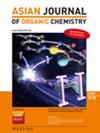Glutathione Peroxidase‐Mimics Organoselenium Amines: Anti‐Ferroptotic Properties and an In Silico Study of 15‐Lipoxygenase‐2
IF 2.8
4区 化学
Q1 CHEMISTRY, ORGANIC
引用次数: 0
Abstract
In search for better synthetic antioxidants, aminic organoselenides carrying amine and benzamide groups at ortho‐positions to the selenium atom were synthesized from alkyl halides and in situ generated sodiumselenolates as nucleophile by the sodium borohydride reduction of corresponding diselenides. The single crystal X‐ray structure of one compound showed the weak intramolecular Se⋅⋅⋅H interactions with free amine group. The presence of Se⋅⋅⋅H interactions was further confirmed using natural bond orbital (NBO) and atoms in molecules (AIM) calculations, respectively. The glutathione peroxidase enzyme (GPx)‐like antioxidant activity of all compounds was evaluated using thiophenol assay. The best antioxidant exhibited nearly 5 and 10 times greater activities than Oct2Se2 and Ph2Se2 used as references, respectively. The most active catalysts carrying a strong electron‐donating group were further investigated at different concentrations of thiol for determining the catalytic parameters. These GPx mimics have shown anti‐ferroptotic activity in a 4‐OH‐tamoxifen (TAM) inducible GPx4 knockout cell line and protected cells from cell death induced by loss of GPx4 enzyme. In silico molecular docking studies showed that all antioxidants demonstrated promising Moldock scores with human 15‐lipoxygenase‐2 enzyme.

谷胱甘肽过氧化物酶-模拟有机硒胺:15-脂氧合酶-2的抗铁性和硅研究
为了寻找更好的合成抗氧化剂,以烷基卤化物和原位生成的硒酸钠为亲核试剂,通过硼氢化钠还原相应的二硒酸钠,合成了在硒原子邻位上携带胺和苯酰胺基团的氨基有机硒化物。其中一种化合物的单晶x射线结构显示出与游离胺基的弱Se⋅⋅⋅H相互作用。利用自然键轨道(NBO)和分子中原子(AIM)进一步证实了Se⋅⋅⋅H相互作用的存在。采用硫酚法测定各化合物的谷胱甘肽过氧化物酶(GPx)样抗氧化活性。最佳抗氧化剂的活性分别比对照的Oct2Se2和Ph2Se2高近5倍和10倍。在不同硫醇浓度下,进一步研究了携带强给电子基团的活性催化剂,以确定催化参数。这些GPx模拟物在4- oh -他莫昔芬(TAM)诱导的GPx4敲除细胞系中显示出抗铁致凋亡活性,并保护细胞免受GPx4酶缺失引起的细胞死亡。在硅分子对接研究表明,所有抗氧化剂表现出良好的Moldock分数与人15-脂氧化酶-2酶。
本文章由计算机程序翻译,如有差异,请以英文原文为准。
求助全文
约1分钟内获得全文
求助全文
来源期刊

Asian Journal of Organic Chemistry
CHEMISTRY, ORGANIC-
CiteScore
4.70
自引率
3.70%
发文量
372
期刊介绍:
Organic chemistry is the fundamental science that stands at the heart of chemistry, biology, and materials science. Research in these areas is vigorous and truly international, with three major regions making almost equal contributions: America, Europe and Asia. Asia now has its own top international organic chemistry journal—the Asian Journal of Organic Chemistry (AsianJOC)
The AsianJOC is designed to be a top-ranked international research journal and publishes primary research as well as critical secondary information from authors across the world. The journal covers organic chemistry in its entirety. Authors and readers come from academia, the chemical industry, and government laboratories.
 求助内容:
求助内容: 应助结果提醒方式:
应助结果提醒方式:


